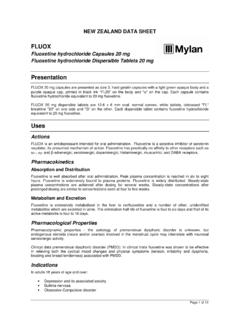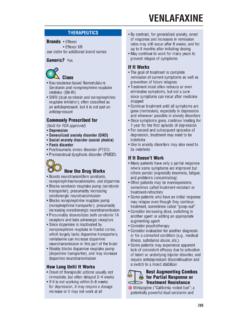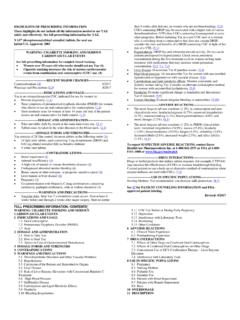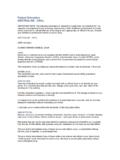Transcription of New Zealand Data Sheet Arrow - Sertraline - …
1 Version Page 1 of 17 NEW Zealand data Sheet 1 NAME OF THE MEDICINE Arrow Sertraline 50, 50 mg, film coated tablets Arrow Sertraline 100, 100 mg, film coated tablets 2 QUALITATIVE AND QUANTITATIVE COMPOSITION Each tablet contains 50 mg or 100 mg of Sertraline as Sertraline hydrochloride. For the full list of excipients, see Section List of excipients. 3 PHARMACEUTICAL FORM Tablets 50 mg: White to off-white, capsule shaped, biconvex, film coated tablets with 50 and BL embossed on either side of the breakline. Tablets 100 mg: White to off-white, capsule shaped, biconvex, film coated tablets with 100 and BL embossed on one side. Do not halve the Arrow - Sertraline 100 tablets. Dose equivalence when the tablet is divided has not been established. 4 CLINICAL PARTICULARS Therapeutic indications Children and Adolescents (6 17 yrs) Arrow - Sertraline is indicated for the treatment of paediatric patients (6 17 years of age) with obsessive compulsive disorder (OCD).
2 Adults Arrow - Sertraline is indicated for the treatment of symptoms of depression, including depression accompanied by symptoms of anxiety, in patients with or without a history of mania. Following satisfactory response, continuation with Sertraline therapy is effective in preventing relapse of the initial episode of depression or recurrence of further depressive episodes. Arrow - Sertraline is indicated for the treatment of obsessive compulsive disorder. Following initial response, Sertraline has been associated with sustained efficacy, safety and tolerability in up 2 years of treatment of OCD. Arrow - Sertraline is indicated for the treatment of panic disorder, with or without agoraphobia. Arrow - Sertraline is indicated for the treatment of post-traumatic stress disorder (PTSD). Arrow - Sertraline is indicated for the treatment of social phobia (social anxiety disorder).
3 Following satisfactory response, continuation with Sertraline therapy is effective in preventing relapse of the initial episode of social phobia. Arrow - Sertraline is indicated for the treatment of premenstrual dysphoric disorder (PMDD). Dose and method of administration Dose Initial Treatment in Adults Depression and OCD Sertraline treatment should be administered at a dose of 50 mg/day. Version Page 2 of 17 Panic Disorder, PTSD and Social Phobia Therapy for panic disorder, PTSD and social phobia should be initiated at 25 mg/day. After one week, the dose should be increased to 50 mg once daily. This dosage regimen has been shown to reduce the frequency of early treatment emergent side effects characteristic of panic disorder. Premenstrual Dysphoric Disorder Sertraline treatment should be initiated with a dose of 50 mg/day, either daily throughout the menstrual cycle or limited to the luteal phase of the menstrual cycle, depending on physician assessment.
4 Patients not responding to a 50 mg/day dose may benefit from dose increases (at 50 mg increments/menstrual cycle) up to 150 mg/day when dosing daily throughout the menstrual cycle, or 100 mg/day when dosing during the luteal phase of the menstrual cycle. If a 100 mg/day dose has been established with luteal phase dosing, a 50 mg/day titration step for three days should be utilized at the beginning of each luteal phase dosing period. Dosage adjustments, which may include changes between dosage regimens ( , daily throughout the menstrual cycle versus during the luteal phase of the menstrual cycle), may be needed to maintain the patient on the lowest effective dosage and patients should be periodically reassessed to determine the need for continued treatment. Titration in Adults For all indications other than PMDD Patients not responding to a 50 mg dose may benefit from dose increases.
5 Dose changes should be made at intervals of at least one week, up to a maximum of 200 mg/day (refer to section above for details on dosage titration for PMDD). The onset of therapeutic effect may be seen within 7 days. However, longer periods are usually necessary to demonstrate therapeutic response, especially in OCD. Maintenance Dosage during long-term therapy should be kept at the lowest effective level, with subsequent adjustment depending on therapeutic response. Paediatric population The safety and efficacy of Sertraline has been established in paediatric OCD patients aged 6 to 17. More than 250 paediatric OCD patients have been exposed to Sertraline in completed and ongoing studies. The safety profile of Sertraline in these paediatric studies is comparable to that observed in adult OCD studies.
6 The administration of Sertraline to paediatric OCD patients (aged 13 to 17) should commence at 50 mg/day. Therapy for paediatric OCD patients (aged 6 to 12) should commence at 25 mg/day, increasing to 50 mg/day after one week. Subsequent doses may be increased in case of lack of response in 50 mg/day increments, up to 200 mg/day, as needed. In a clinical trial in patients aged 6 to 17 years with depression or OCD, Sertraline appeared to have a similar pharmacokinetic profile to that found in adults. However, the generally lower body weights of children compared to those of adults should be taken into consideration in advancing the dose from 50 mg, in order to avoid excessive dosing. The efficacy of Sertraline in paediatric patients with depression or panic has not been demonstrated in controlled trials. Safety and effectiveness in paediatric patients below the age of 6 have not been established.
7 Titration in Children and Adolescents Sertraline has an elimination half-life of approximately one day; dose changes should not occur at intervals of less than one week. Version Page 3 of 17 Special populations Use in Elderly The same dose range as in younger patients may be used in the elderly. Over 700 elderly patients (>65 years) have participated in clinical studies which demonstrated the efficacy of Sertraline in this patient population. The pattern and incidence of adverse reactions in the elderly was similar to that in younger patients. Use in Hepatic Impairment The use of Sertraline in patients with hepatic disease should be approached with caution. A lower or less frequent dose should be used in patients with hepatic impairment (see Section Special warnings and precautions for use). Use in Renal Impairment Sertraline is extensively metabolised.
8 Excretion of unchanged drug in urine is a minor route of elimination. As expected from the low renal excretion of Sertraline , Sertraline dosing does not have to be adjusted based on the degree of renal impairment (see Section Special warnings and precautions for use). Method of administration Arrow - Sertraline should be administered once daily, either in the morning or evening. Arrow - Sertraline tablets can be administered with or without food. Contraindications Arrow - Sertraline is contraindicated in patients with a known hypersensitivity to Sertraline . Concomitant use in patients taking pimozide is contraindicated (see Section Interaction with other medicines and other forms of interaction). Concomitant use in patients taking monoamine oxidase inhibitors (MAOIs) is contraindicated (see Section Special warnings and precautions for use). Special warnings and precautions for use Monoamine Oxidase Inhibitors Cases of serious reactions, sometimes fatal, have been reported in patients receiving Sertraline in combination with a monoamine oxidase inhibitor (MAOI), including the selective MAOI, selegiline and the reversible MAOI, moclobemide and the MAOI drugs, , linezolid (an antibiotic which is a reversible non-selective MAOI) and methylene blue.
9 Such cases presented with features resembling serotonin syndrome, the symptoms of which include: hyperthermia, rigidity, myoclonus, autonomic instability with possible rapid fluctuations of vital signs, mental status changes that include confusion, irritability, and extreme agitation progressing to delirium and coma. Therefore, Sertraline should not be used in combination with an MAOI or within 14 days of discontinuing treatment with an MAOI. Similarly, at least 14 days should elapse after discontinuing Sertraline treatment before starting an MAOI (see Section Contraindications). Serotonin Syndrome (SS) or Neuroleptic Malignant Syndrome (NMS) The development of potentially life-threatening syndromes like serotonin syndrome (SS) or Neuroleptic Malignant Syndrome (NMS) has been reported with SSRIs, including treatment with Sertraline .
10 The risk of SS or NMS with SSRIs is increased with concomitant use of serotonergic drugs (including triptans and fentanyl), with drugs which impair metabolism of serotonin (including MAOIs), antipsychotics and other dopamine antagonists. SS symptoms may include mental status changes ( agitation, hallucinations, coma), autonomic instability ( tachycardia, labile blood pressure, hyperthermia), neuromuscular aberrations ( hyperreflexia, incoordination) and/or gastrointestinal symptoms ( nausea, vomiting, diarrhoea). Some signs of SS, including Version Page 4 of 17 hyperthermia, muscle rigidity, autonomic instability with possible rapid fluctuation of vital signs, and mental status changes resemble NMS. Patients should be monitored for the emergence of signs and symptoms of SS or NMS syndrome (see Section Contraindications).















